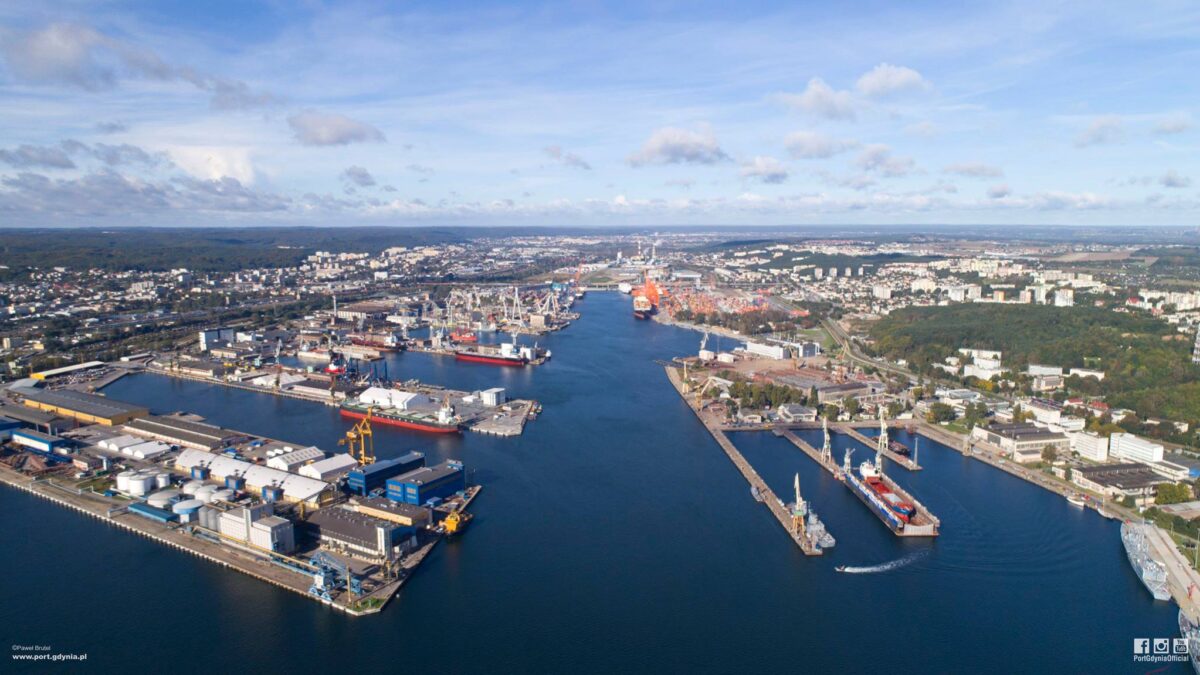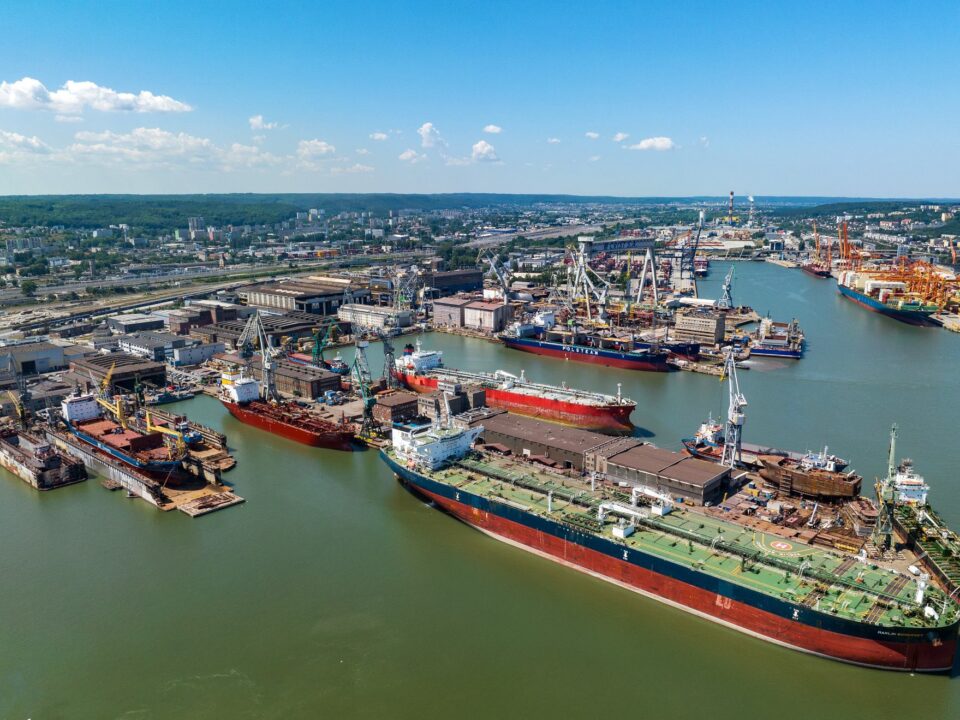
Fleet for the Navy
30 July 2025
H1 in Containers
13 August 2025In 2024, Polish seaports recorded a decrease in the volume of cargo handled, the main reason for which were significant restrictions in coal and grain turnover. At the same time, there was an increase in the general cargo volumes, which, however, failed to compensate for the losses. In the first half of 2025, the situation stabilized and eventually Polish seaports (Gdańsk, Gdynia, Szczecin, Świnoujście and Police) recorded a total increase in turnover of 1.5%, reaching 69 million tons. This result was due to relatively large fluctuations in volumes in individual cargo groups. Particularly severe were declines in grain handling, which amounted to as much as 1.99 million tons. A decrease was also recorded in coal (-384 thousand tons), liquid fuels (-383 thousand tons) and timber. However, the indicated volume losses were supplemented by increases generated in other groups. In particular, general cargoes (+2.63 million tons) and other bulk cargoes (+0.93 million tons) grew. The ports also received more ore (+0.23 million tons).
Port of Gdańsk
The port of Gdańsk ended the first half of the year with a cargo handling growth of 0.4%, handling a total of 38.25 million tons. Interestingly, this result was achieved with exceptionally large changes in individual cargo groups, where significant increases are interspersed with deep declines. This shows how important it is to diversify the assortment served and to universalize seaports. The driver for port turnover was the handling of general cargo and other bulk cargoes. In the case of general cargo, the increase in weight was 1.41 million t (+12.2%), which ultimately allowed 13 million t to be handled. Of particular importance here was containerized cargo, which grew by 14%, translating into a result of 11.6 million t. Bulk cargoes also gained, arriving at 0.38 million t (+25.1%) and reaching a total of 1.91 million t. A very large relative gain (+206.2%) was in ore, although in this case the final turnover was only 161,000 t. Nearly 1 million t was lost in Gdańsk for liquid fuel handling. After a 4.7% decline, transshipments totaled 19.16 million tons. Transshipments of coal and grain fell by about 400,000 t. Finally, the port handled 2.87 million tons of coal (-12.4%) and 1.11 million tons of grain (-26.4%). Timber turnover also declined (29,000 tons). The effect of changes in volumes was, of course, shifts in the share structure of the various commodity groups. Liquid fuels remained in the lead (50.1%), although they lost 2.7 p.p. General cargo gained (+3.6 p.p.), accounting for 34% of transshipments. In other cases, the changes were smaller. Grain and coal each lost 1.1 p.p., while other bulk cargoes (+1.0 p.p.) and ore (+0.3 p.p.) gained.
Port of Gdynia
In the first half of 2025, the port of Gdynia handled a total of 13.06 million tons, a 4.8% decline in turnover compared to the same period last year. The main culprit for the situation was restrictions in handling grain and feed, as the port lost 1/3 of the volumes in this group. As a result, grain transshipments amounted to 2.20 million tons. Liquid fuel transshipments also declined (-19.8%), and less other bulk cargoes (-2.9%) and timber (-16.8%) were handled. However, while the changes for fuels are 316 thousand tons less, for the other 2 groups the total loss is only 24 thousand tons. Positive changes, however, were observed in 2 groups. The largest growth (+764 thousand tons) was achieved in general cargo, which totaled 8.47 million tons handled. Again, containerized cargo turnover was key, growing at a rate of 19.2% and totaling 536.2 thousand TEUs. Interestingly, coal transshipments also grew (+5.7%), which eventually amounted to 585 thousand tons at the port. The high growth in general cargo turnover resulted in further strengthening of this cargo group in the volume structure. The final share was 64.9%. The shares of the second group – grain and feed – declined. After significant reductions, the share reached 16.9% (-7.3 p.p.). Liquid fuels account for another 9.8% share (-1.8 p.p.). In other cases, structure adjustments were cosmetic in nature and did not exceed 0.4 p.p.
Ports of Szczecin and Świnoujście
The ports of Szczecin and Świnoujście achieved the largest increases in transshipments, both relative (+7.7%) and absolute (+1.23 million tons). Significantly, in this case, all cargo groups gained, only grain recorded a decline. The poles of growth were trade in liquid fuels, general cargo and other bulk cargo. Liquid fuel transshipments increased by as much as 23.6% (+0.89 million tons), which translated into a total volume of 4.65 million tons. The key driving factor in this case was the activity of the LNG Terminal in Świnoujście, which increased its handling and storage potential after the construction of a third gas tank. This resulted in a 40.8% increase in volume and the handling of 3 million tons of LNG. In the case of general cargo, the change is 5.6% (+0.45 million t), with a final result of 8.50 million t. Noteworthy in this case is container transshipment of more than 50,000 TEUs in the first half of the year, a nearly 50% increase in traffic. The 2 million t level was exceeded by the turnover of other bulk cargoes (2.02 million t), as a result of a 14.5% increase. Although the increase in ore, timber and coal transshipments was small (+113 thousand tons in total) it supported the final result. On the other hand, grain transshipments were losing, having fallen by nearly 40% (-0.48 million tons) to only 701,000 tons. As a result of the indicated changes, the shares of the various cargo groups shifted. Liquid fuels gained the most (3.5 p.p.), which together account for 27.1% of total transshipments and are the second cargo group handled by the ports on the west coast. The leader here is general cargo, with a 49.5% share, which, however, lost 1 p.p. of its share in the structure in the first half of the year, despite volume increases. Other bulk cargoes, that came third on the list, gained. An increase of 0.7 p.p. allowed to reach 11.8%. Losses were recorded in grain and fodder (-3.3 p.p.) and coal and coke (-0.2 p.p.), which came next, reaching a share of 4.1% and 3.7%, respectively. Ore gained (2.7% share), and timber shares were unchanged (1.1%).
Port of Police
The first half of the year was a successful period for the port in Police, as transshipments here increased 2.5 times. In the end, 532.6 thousand tons of cargo passed through the port, providing a good basis for a return to volumes exceeding 1 million tons per year, as was the case before 2022. Such a radical increase in transshipments was recorded by other bulk cargo, which currently accounts for 93.3% of the total port turnover. Ore also appeared in the port, with 30.9 thousand tons handled, which means that it is the second cargo in the volume structure of Police (0.7% share). There was a significant drop in coal handling (-84.5%), with only 3,500 tons left at the port. The last of the cargoes handled is general cargo. In this case, the 3.5-fold increase represents handling of 1.1 thousand tons and 0.2% in the cargo structure.
The article was written in collaboration with Namiary Na Morze i Handel – a biweekly magazine providing expert information on the most important events and issues in the Polish maritime economy.





